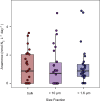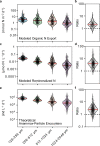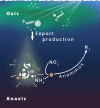Small sinking particles control anammox rates in the Peruvian oxygen minimum zone
- PMID: 34050175
- PMCID: PMC8163745
- DOI: 10.1038/s41467-021-23340-4
Small sinking particles control anammox rates in the Peruvian oxygen minimum zone
Abstract
Anaerobic oxidation of ammonium (anammox) in oxygen minimum zones (OMZs) is a major pathway of oceanic nitrogen loss. Ammonium released from sinking particles has been suggested to fuel this process. During cruises to the Peruvian OMZ in April-June 2017 we found that anammox rates are strongly correlated with the volume of small particles (128-512 µm), even though anammox bacteria were not directly associated with particles. This suggests that the relationship between anammox rates and particles is related to the ammonium released from particles by remineralization. To investigate this, ammonium release from particles was modelled and theoretical encounters of free-living anammox bacteria with ammonium in the particle boundary layer were calculated. These results indicated that small sinking particles could be responsible for ~75% of ammonium release in anoxic waters and that free-living anammox bacteria frequently encounter ammonium in the vicinity of smaller particles. This indicates a so far underestimated role of abundant, slow-sinking small particles in controlling oceanic nutrient budgets, and furthermore implies that observations of the volume of small particles could be used to estimate N-loss across large areas.
Conflict of interest statement
The authors declare no competing interests.
Figures







Similar articles
-
Aerobic Microbial Respiration In Oceanic Oxygen Minimum Zones.PLoS One. 2015 Jul 20;10(7):e0133526. doi: 10.1371/journal.pone.0133526. eCollection 2015. PLoS One. 2015. PMID: 26192623 Free PMC article.
-
Denitrification as the dominant nitrogen loss process in the Arabian Sea.Nature. 2009 Sep 3;461(7260):78-81. doi: 10.1038/nature08276. Nature. 2009. PMID: 19727197
-
Organic matter stoichiometry, flux, and oxygen control nitrogen loss in the ocean.Science. 2014 Apr 25;344(6182):406-8. doi: 10.1126/science.1248364. Epub 2014 Apr 10. Science. 2014. PMID: 24763588
-
[Bacterial anaerobic ammonia oxidation (Anammox) in the marine nitrogen cycle--a review].Wei Sheng Wu Xue Bao. 2009 Mar;49(3):281-6. Wei Sheng Wu Xue Bao. 2009. PMID: 19623949 Review. Chinese.
-
Anammox revisited: thermodynamic considerations in early studies of the microbial nitrogen cycle.FEMS Microbiol Lett. 2015 Aug;362(15):fnv114. doi: 10.1093/femsle/fnv114. Epub 2015 Jul 13. FEMS Microbiol Lett. 2015. PMID: 26174999 Review.
Cited by
-
Microbial Activities and Selection from Surface Ocean to Subseafloor on the Namibian Continental Shelf.Appl Environ Microbiol. 2022 May 10;88(9):e0021622. doi: 10.1128/aem.00216-22. Epub 2022 Apr 11. Appl Environ Microbiol. 2022. PMID: 35404072 Free PMC article.
-
The marine nitrogen cycle: new developments and global change.Nat Rev Microbiol. 2022 Jul;20(7):401-414. doi: 10.1038/s41579-022-00687-z. Epub 2022 Feb 7. Nat Rev Microbiol. 2022. PMID: 35132241 Review.
-
Microscale dynamics promote segregated denitrification in diatom aggregates sinking slowly in bulk oxygenated seawater.Commun Earth Environ. 2023;4(1):275. doi: 10.1038/s43247-023-00935-x. Epub 2023 Jul 28. Commun Earth Environ. 2023. PMID: 38665198 Free PMC article.
-
Bacterial clustering amplifies the reshaping of eutrophic plumes around marine particles: A hybrid data-driven model.PLoS Comput Biol. 2024 Dec 11;20(12):e1012660. doi: 10.1371/journal.pcbi.1012660. eCollection 2024 Dec. PLoS Comput Biol. 2024. PMID: 39661660 Free PMC article.
-
Collaborative metabolisms of urea and cyanate degradation in marine anammox bacterial culture.ISME Commun. 2024 Jan 10;4(1):ycad007. doi: 10.1093/ismeco/ycad007. eCollection 2024 Jan. ISME Commun. 2024. PMID: 38304081 Free PMC article.
References
-
- Codispoti LA, et al. The oceanic fixed nitrogen and nitrous oxide budgets: moving targets as we enter the anthropocene? Sci. Mar. 2001;65:85–105. doi: 10.3989/scimar.2001.65s285. - DOI
-
- Gruber N, Sarmiento JL. Global patterns of marine nitrogen fixation and denitrification. Glob. Biogeochem. Cycles. 1997;11:235–266. doi: 10.1029/97GB00077. - DOI
-
- Gruber, N. In The Ocean Carbon Cycle and Climate (eds Follows, M. & Oguz, T.) 97–148 (Springer Netherlands, 2004).
-
- Kalvelage T, et al. Nitrogen cycling driven by organic matter export in the South Pacific oxygen minimum zone. Nat. Geosci. 2013;6:228–234. doi: 10.1038/ngeo1739. - DOI
Publication types
MeSH terms
Substances
LinkOut - more resources
Full Text Sources
Other Literature Sources
Miscellaneous

